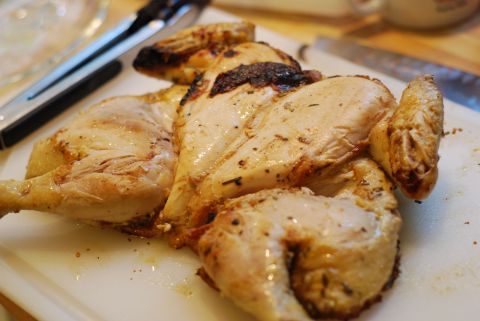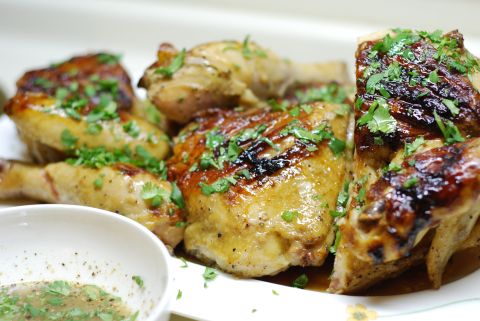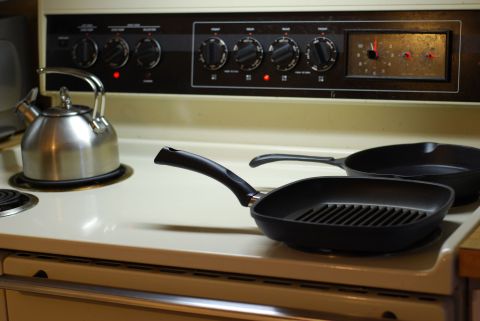Lemongrass-Cilantro-Lime Marinade (for chicken or pork)
September 13, 2016 § 2 Comments
Over the years (decades really) I’ve experimented with various herbs. My first set of cooking explorations were with dried basil. Which evolved to other dried herbs like oregano, marjoram, thyme, rosemary, sage, etc. As my cooking skills improved I moved on to fresh herbs and even grew my own. I eventually moved on to experimenting with less common culinary flavorings like rose water, sumac, and galangal. With the melting pot of produce available these days I’ve been able to explore a whole new world with fresh ingredients. My latest…Lemongrass.
I’ve always enjoyed the lemongrass flavor in southeast asian cuisine. I tried using dried lemongrass but found the flavor never truly carried through and the hard splintery pieces often ruined the texture of the food.
I am certainly not an expert in utilizing lemongrass but below is a recipe that I’ve made several times and the results have been consistently good. To help infuse the flavor of the lemongrass into the marinade I slice the stalks lengthwise and hammer it with a meat tenderizer. I keep the chunks big enough so any chewy strips can be easily picked out.
NOTE: I like to serve this with two toppings – a fresh chopped herb combination and fried shallots (recipes below). You can also spice-up this dish with Korean Bi Bim Bap sauce as a condiment.
Lemongrass-Cilantro-Lime Marinade (for chicken or pork)
MARINADE:
¼ cup Lime Juice
2 Tbls. Fish Sauce
1 Tbls. Soy Sauce (use gluten free soy to make this a GF recipe)
1 Tbls. Sherry or Brandy
1 tsp. Brown Sugar
1 Tbls. Garlic, chopped
2 Tbls. Cilantro, fresh chopped
1 Tbls. Scallions, chopped
1 stalk Lemongrass, fresh crushed*
White Pepper
1 to 1 ½ lb. Chicken, boneless breasts or thighs
or
1 rack Pork Baby Back Ribs
or
1½ to 2 lb. Country Style Ribs, or bone-in pork chops
* Crush lemongrass by slicing stalks into 3-4 inch pieces, then slice them lengthwise and hammer it with a meat tenderizer. This will help the flavor blend into the marinade better.

Marinade – In a bowl, combine lime juice, fish sauce, soy sauce, sherry or brandy, brown sugar, garlic, cilantro, scallions, lemongrass, and white pepper.

Pour mixture on meat, coating well. Place chunks of lemongrass between meat to help the flavor disperse. Let it marinate at least 1 hour to overnight.
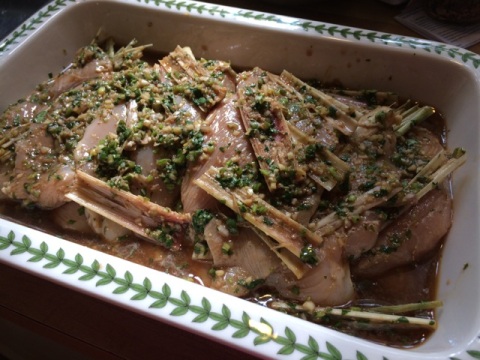
Grill meat – Grill chicken on medium high heat with an open lid. Meat should be browned and cooked through. Thin pieces generally cook in 10-15 minutes.

Grill ribs on low heat with a covered lid. Depending on the thickness of the ribs, it will take about 20-30 minutes on each side. Monitor grilling because fatty areas of ribs may cause flame to flair and cause charring of ribs.

Alternately, chicken can be cooked using a grill pan and ribs can be baked in an oven.
TOPPING 1: FRESH HERBS
¼ cup Basil, fresh chopped
¼ cup Cilantro, fresh chopped
¼ cup Mint, fresh chopped
1 Tbls. Scallions, chopped (optional)
In a bowl, combine basil, cilantro, mint, and scallions, stirring herbs until they are mixed evenly.
TOPPING 2: FRIED SHALLOTS
2 lg. Shallots, sliced
1 cup Vegetable Oil (or Canola)
Heat oil in small pan so oil is about ½-inch deep. Carefully add 1/3 of shallots into hot oil and cook until light brown. Remove cooked shallots with slotted spoon onto paper towel. Repeat with each third. Shallot flavored oil can be saved for use in other dishes.

Serving suggestions – Serve meat on cooked sushi or long-grain rice. Sprinkle herb mixture and fried shallots on top. If you like a hot kick to the dish, add Korean Bi Bim Bap sauce (seasoned red pepper paste). You can also make a side dish of Spicy Cucumbers – Slice cucumbers tossed in some Bi Bim Bap sauce.
NOTE: Below is a photo of the ribs without fried shallots. I forgot to take a plated photo of the chicken version (sorry).

Uccello Arrabbiato Sotto un Mattone (Angry Bird Under a Brick)…really, Southeast Asian Chicken with Pepper-Lime Dip
May 22, 2012 § 1 Comment
I’ve been away from blogging for over a month now all because of Angry Birds. Not because I’ve been addicted to the game (well, mildly addicted) but it’s my dear little boy who loves to play. When he is not playing on my iPhone, he is playing with his toy King Pig, Black Bird, and the three little Blue Birds. One afternoon he decided that the kitchen table was a great place to play. Consequently, knocking a glass of water onto Mom’s laptop and completely frying it…yes, it was actually sizzling…thus, no blogging.
I don’t really have a good excuse for not blogging for so many weeks. I’ve been up and running on my new MacBook Pro for weeks now but I’ve had a bit of a creativity block because I keep thinking of exacting my revenge on those darn birds. For weeks now I’ve been experimenting on various versions of squished poultry and pork. At one point I even had sausage stuffed inside a chicken breast (not bad but not blog-worthy).
I came to the conclusion that this whole incident is due to those darn birds! So what better way to get revenge than to squash those little buggers!! Squashing a whole bird under a cast iron pan proved to be quite satisfying. Although, perfecting the technique took quite a bit of work.
If you read the numerous recipes that come up in a Google search for pollo al mattone (chicken under a brick) they all make it sound simple – split a chicken, season, put a few bricks on it while cooking – poof! Perfect chicken! Not quite so easy. The main problems I came across was burning the chicken skin and/or under cooking it. If your marinade has any sweetener, which mine often do, caramelizing occurs and the skin of the chicken can burn or stick to the pan and foil. The first time I tried this the entire skin of the chicken stuck to my pan. I had a deliciously flavored skinless chicken.
The theory behind cooking chicken under a brick is centuries old. Meats such as beef and lamb retain a juicy tenderness due to the fat content that is marbled through the meat. Chicken on the other hand is quite lean and relies on its natural juices to be moist. Technically the use of placing a heavy object on the chicken while cooking is to retain the natural juices by cutting the cooking time and trapping the moisture before it evaporates.
Besides the problem of my chicken sticking and/or burning I initially didn’t find that my chicken cooked any faster. If anything I found it was consistently undercooked. I resolved that the problem was that my “weight” was cold. When I heated my weight prior to putting it on top of the chicken I found it cooked much more evenly. I was able to lower the heat so the chicken did not burn but it still cooked in a reasonable amount of time.
I started with a Tuscan seasoned chicken, which tasted wonderful but after making it three times and not being satisfied with the technical results of the preparation I simply got bored of it (it’s a great recipe so I’ll blog it at a later date). So I continued my experimenting with a completely different flavoring. I moved from Italy to Southeast Asia.
This recipe for Southeast Asian Chicken with Pepper-Lime Dip is full of flavor. If you have the time I highly recommend marinating the chicken overnight. It’s adapted from one of my favorite Williams-Sonoma cookbooks, Savoring Southeast Asia by joyce Jue. This recipe is very similar to their recipe for Mouan Ang.
One last note, although I feel quite satisfied with finally squashing the bird, I have to admit that I found this technique a little more work than necessary. My normal technique for roasting a chicken is to split and flatten it as I do in this recipe but simply bake it raised on a rack with a half-inch of water underneath. The steam from the water helps retain the moisture. But I did like the charred flavor of searing the chicken in a grill pan prior to baking.
Weather did not allow me to test this recipe on the grill so when I get the opportunity I will update this post with grilling instructions.
Southeast Asian Chicken with Pepper-Lime Dip
One 4 lb. Chicken, flattened (directions below) or split a whole chicken into two halves
1 Tbls. plus 2 tsp. Black Peppercorns or fresh ground using a coarse setting, separated
3 tsp. Salt, preferably a coarse type such as Maldon Salt Flakes or coarse Kosher Salt, separated
5 cloves (about 3 Tbls.) Garlic, chopped
3 Tbls. Low-sodium Soy Sauce
1 Tbls. Fish Sauce
1 Tbls. Turbinado Sugar (regular sugar can be used also)
3 Tbls. Vegetable Oil, separated
Fresh Coriander, coarsely chopped
2 Limes
FLATTEN CHICKEN: Using sharp kitchen scissors, cut a whole chicken along one side of the spine. The spine can be removed by cutting along the other side but I prefer to leave the spine on (I like to pick at the meat along the bone).
Turn the chicken skin side down. Using a sharp knife, make a small cut along the top of the breastbone. This step is not necessary but it helps to get the chicken nice and flat. Flip the chicken bone side down. Using the palm of your hand, press down on the breast area of the chicken so it flattens.
You can leave the wings so they fall between the breast and thigh or twist the wing tip up over the first joint. Flipping the wing tip up will pull the wing to the top area of the breast and allow the breast and thigh area to brown and cook more evenly. Alternately, you can slice through the breastbone to split the chicken into two halves.
MARINATE: Using a mortar and pestle, grind 2 tsp. black peppercorns (or coarsely ground black pepper) and 2 tsp. coarse salt.
Add garlic and grind together (it will be almost paste-like).
Put mixture into a bowl. Add soy sauce, fish sauce, Turbinado sugar, and 1 Tbls. oil. Stir mixture until sugar is dissolved.
Place the flattened chicken into a platter. Cover both sides with marinade.
For added flavor, lift the skin at the top of the breast (there will be 2 pockets, one for each side of the breast) and spoon in 1 tsp. of marinade into each breast pocket between skin and meat. Using your fingers or a butter knife, rub marinade down so it spreads evenly.
At the butt end of the chicken you can lift the skin gently at the top of the thigh and spoon in 1 tsp. of marinade into each thigh pocket. Rub the marinade down so it is spread evenly.
Place the chicken in refrigerator to marinate for 4 hours to overnight.
COOKING: Preheat the oven to 325°. Place a cast-iron pan in the oven to heat. Alternately you can place it on the stove at medium heat.
Heat a grill pan on medium-high heat. Add 2 Tbls. oil to pan, swirling it around to coat evenly. Place the chicken, skin side down, onto pan.
NOTE: I have a small grill pan so I had to split my chicken in half and cook each half separately.
Cover with a sheet of aluminum foil then place hot cast-iron pan on top. If you would like additional weight fill a kettle with water, bring it to a boil and place the full hot kettle on top (note: if the kettle is cold it will cool the temperature of the cast-iron pan).
Lower the heat to medium to medium-low and cook for 10 minutes. You want the skin to sear but not burn.
Remove the kettle, cast-iron pan, and foil. Place the chicken skin side up into a baking pan.
Place foil and cast iron pan back on top of chicken (I did not use the kettle for this step) and place the pan in the oven. Cook for 10-15 minutes.
While the chicken is baking, place the limes, cut side down on the grill pan and cook at medium-low heat for 5 minutes.
Remove chicken from oven and let it sit for 5 minutes before serving.
SERVING: Chicken can be carved as desired. Sprinkle coriander on top of chicken. In a small bowl, squeeze the juice out of the limes, add 1 tsp. salt and 1 Tbls. black pepper, and stir well. Optional: You can add 1 tsp. chopped coriander to the dip. The pepper-lime sauce should be served on the side as a dipping sauce.
For those of you who are like me and like to have an old fashion printed copy of recipes, the below link is to a PDF (minus photos to keep it on one page).
Three Rose Marinade (for Lamb Chops or Cornish Hen)
February 15, 2012 § Leave a comment
Roses for Valentine’s Day is wonderful but even better if you can eat them. Well, not really eat them because you just don’t know what has been sprayed on them. So instead I offer a recipe using rosemary, rose peppercorns, and rose water.
This is a recipe I developed quite a while ago when I first saw the movie, Like Water for Chocolate. As I sat there in the dark movie theater, the cooking-nerd in me thought, “Wow! Can you really cook with roses?” For those who have seen the movie, you can probably guess which scene inspired my culinary creativity . For those who have not seen the movie I’ll just say that I hope this recipe will invoke feelings of pleasure and excitement…
NOTE: Updated this page on March 8th – corrected typo in PDF and added two photos of Cornish Hen.
Three Rose Marinade (for Lamb Chops or Cornish Hen)
If using lamb rib chops, slice each steak with two ribs so the meat is about 1 ¼ to 1 ½ inches thick. This will help keep the chops medium to medium rare. Lamb Kidney Chops (looks like a mini T-bone steak) are generally sliced thick. This marinade also works well with Cornish Hens. Split each hen in half (neck to tail).
1 ¼ to 2 lb Lamb Rib or Kidney Chops or 2 Cornish Hens, split
2 Garlic Cloves, chopped
2 tsp. Brown Sugar
1 tsp. Rosemary, fresh chopped
½ tsp. Rose Peppercorns, ground
dash Cloves, ground
¼ tsp. Salt
2 Tbls. Balsamic Vinegar
¼ cup Port (or Red Wine)
2 Tbls. Rose Water
¼ cup Olive Oil
Combine garlic, brown sugar, rosemary, rose peppercorns, cloves, salt, balsamic vinegar, Port, rose water, and olive oil. Mix with a fork or whisk until sugar is dissolved. Add to meat and marinate at least 30 minutes and up to overnight.
IF PREPARING LAMB: Heat 2 tablespoons olive oil in a grill pan. Sear chops on each side for about 4 minutes on medium-high heat. Alternately, chops can be cooked on an outdoor grill or broiled in the oven.
IF PREPARING CORNISH HENS: Bake hens in a preheated 350° oven for 35 minutes, basting once about 20 minutes into cooking. Alternately, the hens can be prepared on an outdoor grill. Sear skin side first, then cook bone side down at medium heat if using a gas grill or indirect heat if using coal or wood.
SERVING RECOMMENDATIONS: This recipe pairs well with roasted potatoes or rice pilaf.
SALAD RECOMMENDATION: Arugula Salad – mix baby arugula, radicchio, and Belgium endive. Top with slices of ripe but firm pear and slivers of red onion. For dressing drizzle one part Sour Pomegranate Syrup and two parts Greek (Kalamata) olive oil or one part fresh lemon juice and two parts Greek (Kalamata) olive oil. Sprinkle with fresh ground salt and pepper.
For those of you who are like me and like to have an old fashion printed copy of recipes, the below link is to a PDF (minus photos to keep it on one page).
Three Rose Marinade (for Lamb or Cornish Hen) (GF).pdf
* Gluten allergy and intolerance has become increasingly common. I will not go into detail about the specific symptoms, causes, or differences but I will note beside the recipe titles “(GF)” for those recipes that are gluten free. Please note that although I have labeled these recipes to be gluten free you must do your due diligence to review ingredient labels of prepared products to verify that they are truly gluten free. Also consider the side you choose to serve. In some recipes I recommend pasta or bread, which in most cases are not gluten free.
Casserole-Roasted Chicken with Tarragon (GF) and Casserole-Roasted Chicken with Lemon Rosemary and Thyme
February 5, 2012 § 1 Comment
Butter vs. Olive Oil – Casserole-Roasted Chicken
When I was young I was equally fascinated watching Julia Child as much as Sesame Street on PBS. It was the beginning of my fascination with cooking in the French style. If you have ever prepared any of Julia Child’s recipes you will see 2 common ingredients: lardons (fatty bacon) and butter. She also lived to be 91 so I have no comment about the health implications of such a diet. But many of us can only consume so much butter and pork fat on a day-to-day basis.
This post is not about the health benefits of cooking with one fat verses another. It is simply an experiment to compare the culinary results of using butter versus olive oil to prepare a casserole-roasted chicken. A chicken cooked in this fashion is tender and succulent, with a delicate aromatic flavor, but sometimes you just want an alternative to using a stick of butter.
Putting aside flavor, a significant difference between cooking with butter versus olive oil is the smoking temperature. This is the temperature at which the cooking oil will break down and produce an acrid smoke. For butter, that temperature is 300 degrees, where as olive oil has a much higher threshold of 375 degrees.
What this signifies is that butter, while less tolerant to high heat, will also brown what you are cooking more quickly. The following photo is an example of the browning results between the two oils.
Left: Chicken seared in butter Right: Chicken seared in olive oil.
As for the flavor and consistency of preparing the chicken in butter versus olive oil, both chickens came out equally tender and succulent but obviously projected the unique flavor attributes of the cooking fat. The chicken roasted with butter has a rich, almost creamy-smooth texture and flavor. The olive oil roasted chicken also has a rich quality and smooth texture but not the same creaminess as the butter roasted chicken.
Below are two recipes, Casserole-Roasted Chicken with Tarragon, which requires butter and Casserole-Roasted Chicken with Lemon Rosemary and Thyme, which requires olive oil. I opted to post two separate recipes instead of using a single recipe prepared separately using the two oils because I felt the flavor of butter melded better with tarragon and olive oil was enhanced with Mediterranean seasoning. I wouldn’t place one recipe superior to the other but try it for yourself to compare…
Casserole-Roasted Chicken with Tarragon – butter recipe
This recipe is inspired by Julia Child’s Poulet Poêle À L’Estragon. (Sorry Julia, I do not truss my chicken for my Tarragon Chicken recipe). I have followed her recipe exactly and I do admit that the breast meat of the chicken is a bit juicier when the bird is trussed. Also, if you would like to serve your chicken intact you will need to truss the bird and increase the cooking time in this recipe by approximately 10 minutes. If you do not truss the chicken, as I do in this recipe, the legs will fall loose when you pick it up out of the pan. I prefer to carve the bird prior to serving so it’s not important to me to have the bird in one piece. For personal taste I add garlic and increased the vegetables used in this recipe.
1 whole 3-5 lb Roasting Chicken
4 Tbls. Butter, separated
1 tsp. Tarragon, dried (2 tsp. chopped fresh)
Salt and Pepper
1 Tbls. Vegetable Oil
1 cup Sweet Onion, diced
1 – 8 oz. bag (½ lb) Baby Carrots or sliced regular carrots
5 cloves garlic, whole with skins on
½ tsp. Tarragon, dried (1 tsp. chopped fresh)
1 cup Chicken Broth
½ Tbls. Cornstarch
1 Tbls. Marsala
¼ tsp. Tarragon (½ tsp. chopped fresh)
Brush 2 tablespoons melted butter on the outside and inside of the chicken. Then sprinkle the tarragon, salt and pepper on the outside and inside of the chicken.
Preheat oven to 325°. Melt 2 tablespoons butter and vegetable oil in a Dutch Oven or heavy stove-to-oven-safe pan. Brown the chicken on all sides, starting with the breast side first. Remove chicken to a platter.
In the same pan, sauté onions, carrots, garlic, and ½ teaspoon tarragon for 3-5 minutes. Return the chicken to the pan, breast side up. Using a bulb baster, baste the chicken with the liquid in the pan, squirting juice into the chicken cavity as a last step. Cover chicken with a piece of aluminum foil, then cover with the pan lid. Bake 35 minutes for a 3 lb chicken, 45 minutes for a 5 lb chicken. The chicken is done when the drumstick moves in their sockets.
NOTE: The length of time to cook will vary based on the type of pan or dish you are using. The time I recommend is based on using a heavy non-stick cast iron pan. Julia Child recommends 1 hour 10 minutes for a chicken weighing 3 lb and 1 hour 30 minutes for a 5 pounder, which I found to be too long. Her lengthier time is probably due to her chicken being trussed and the recipe was written in 1961, when it was more common to cook poultry well-done.
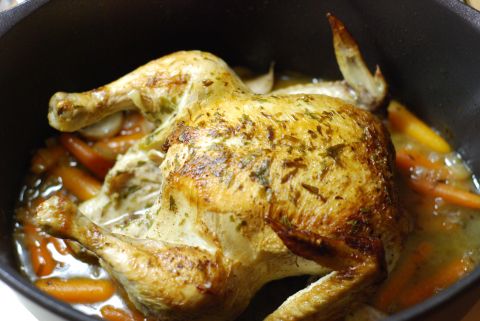
Remove chicken to a platter. Skim off excess oil in pan. Remove garlic to a small plate. Remove the garlic skins and using the tines of a fork, mash garlic into a paste. Return garlic paste to the pan and stir into juices. Add chicken broth to pan and bring the mixture to a boil on the stovetop. Combine cornstarch and Marsala in a small bowl. Stir cornstarch mixture into pan, mixing well to prevent lumpiness. Add ¼ teaspoon tarragon and simmer for 3 minutes to let herb flavor meld into sauce. (See recipe below for Casserole-Roasted Chicken with Lemon Rosemary and Thyme for images of making garlic paste and sauce)
SERVING RECOMMENDATIONS: Carve chicken per your own preference and pour sauce and vegetables over chicken. This recipe is great with roasted or mashed potatoes or rice pilaf.
For those of you who are like me and like to have an old fashion printed copy of recipes, the below link is to a PDF (minus photos to keep it on one page).
Casserole-Roasted Chicken with Tarragon.pdf
Casserole-Roasted Chicken with Lemon Rosemary and Thyme – olive oil recipe
This recipe is prepared identically to my recipe for Casserole-Roasted Chicken with Tarragon, which was inspired by Julia Child’s Poulet Poêle À L’Estragon. But I wanted to experiment using olive oil instead of butter, which compelled me to use Mediterranean herbs.
1 whole 3-5 lb Roasting Chicken
½ Lemon
1 tsp. Rosemary, fresh
1 tsp. Thyme, fresh
Salt and Pepper
1 Tbls. Honey
2 Tbls. Sherry
5 Tbls. Olive Oil, separated
5 cloves garlic, whole with skins on
1 cup Chicken Broth
½ Tbls. Cornstarch
1 Tbls. Sherry
Squeeze out the juice of half a lemon into a small bowl and set aside. Rub the chicken skin and inside of the cavity with the remaining lemon skin/rind. In the bowl of lemon juice, add honey, sherry and 2 tablespoons olive oil. Brush the mixture outside and inside of the chicken. Sprinkle the rosemary, thyme, salt, and pepper outside and inside of the chicken.
Preheat oven to 325°. Heat 3 tablespoons olive oil in a Dutch Oven or heavy stove-to-oven-safe pan. Brown the chicken on all sides, starting with the breast side first. Add garlic. Cover chicken with a piece of aluminum foil, then cover with pan lid. Bake – 35 minutes for a 3 pound chicken, 45 minutes for a 5 pound chicken. The chicken is done when the drumstick moves in their sockets.
NOTE: The length of time to cook will vary based on the type of pan or dish you are using. The time I recommend is based on using a heavy non-stick cast iron pan. Julia Child recommends 1 hour 10 minutes for a chicken weighing 3 lb and 1 hour 30 minutes for a 5 pounder, which I found to be too long. Her lengthier time is probably due to her chicken being trussed and the recipe was written in 1961, when it was more common to cook poultry well-done.
Remove chicken to a platter. Skim off excess oil in pan. Remove garlic to a small plate. Remove the garlic skins and using the tines of a fork, mash garlic into a paste. Return garlic paste to the pan and stir into juices. Add chicken broth to pan and bring the mixture to a boil on the stovetop. Combine cornstarch and Sherry in a small bowl. Stir cornstarch mixture into pan, mixing well to prevent lumpiness. Add a pinch of fresh rosemary and thyme to sauce.
SERVING RECOMMENDATIONS: Carve chicken per your own preference and pour sauce over chicken. This recipe is great with roasted or mashed potatoes, egg noodles, or rice pilaf.
For those of you who are like me and like to have an old fashion printed copy of recipes, the below link is to a PDF (minus photos to keep it on one page).
Casserole-Roasted Chicken with Lemon Rosemary and Thyme.pdf
* Gluten allergy and intolerance has become increasingly common. I will not go into detail about the specific symptoms, causes, or differences but I will note beside the recipe titles “(GF)” for those recipes that are gluten free. Please note that although I have labeled these recipes to be gluten free you must do diligence to review ingredient labels of prepared products to verify that they are truly gluten free. Also consider the side you choose to serve. In some recipes I recommend pasta or bread, which in most cases are not gluten free.

